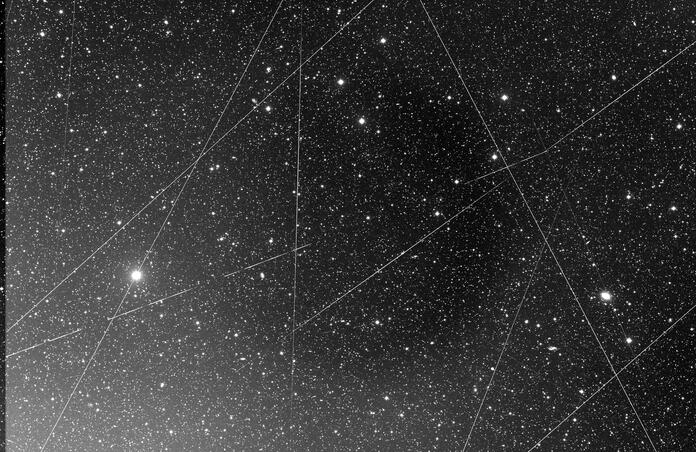SpaceX's Starlink: Is It A Curse Or A Blessing?

In this format, we talk about topics that have sparked discussions in our Facebook Community.
This week, let’s dig into one of the most discussed topics in the Astronomy community these days.
Interestingly, on 8th April 2021, Europe's biggest astronomy conference and exhibition, AstroFest, hosted a talk focused on the threat to astronomy from satellite mega-constellations. During the webinar, astrophysicists and researchers showed their worries about the impact of many satellites on astronomical observations and scientific research.
Our tutor Nik Szymanek discussed how amateur astronomers could prevent the streaks of light from mega satellite constellations blighting their images. Furthermore, he gave a live demonstration showing post-processing techniques to get rid of satellites trails.
The discussion continues with Andre’s post from the Telescope Live Community Group on Facebook:
"We all love astronomy; we love space and always want to know what’s behind our solar system. With SpaceX on the horizon, I think we are closer to our goal being a multiplanetary species than we could have expected a few years ago.
SpaceX was founded on May 6th, 2002 so almost 18 years ago by Elon Musk. Never ever we would have expected such tremendous impact in space exploration.
Falcon 9 firstly launched in June 2010 and from that point on was developed in rocket speed into a reusable full functional rocket. (first successful re-landing was on April 6th 2016.)
As for all space enthusiasts this is the blessing we were waiting for. But next to the rocket science SpaceX also wants to provide huge bandwidth internet all around the world – which of course is only possible via satellites.
So, on May 24th, 2019 they launched its first functional Starlink satellites to Earth orbit (aprox.: 550km). What for many people around the world (with no functional Internet) might be a blessing for a lot of astronomers and astro-photographers it’s a curse.
In 2021 SpaceX is going to plan 2 starts per month for satellites this means around 1500 satellites by the end of the year 2021. (approx.: 60 per launch - all in all around 12.000.)
In conclusion to this the number of satellites in the sky will be huge in the upcoming years. Not to mention the amount of space scrap in earth orbit.
Even though SpaceX promised it will have no effect in the night sky, we already have evidence."
So, what does the community think? Is it a curse or a blessing? Will the night sky change? What's the impact for astrophotographers?
"As an amateur astrophotographer, Starlink is not likely to affect us."
As an amateur astrophotographer, Sean thinks Starlink is not likely to affect the community.
Things have already happened to alleviate the iridium flares and overall brightness of the Starlink satellites. They are brighter while getting into position, but afterwards, they are barely noticeable, and sigma clipping pretty much takes care of it.
It affects research facilities, and Elon Musk, along with SpaceX, is working with these organizations to come up with solutions.
Most of astrophotographers will not experience many adverse effects of Starlink. Sean says he was imaging all night last night (mid-February 2021) and did not have many trails.
He thinks people have worked themselves up into anger about Starlink without really knowing about it.
People see 1 or 2 satellites in their image and get upset, but unfortunately, they were always there, even before Starlink.
"It does not look good on long exposure pictures"
Diane is worried as it does not look suitable for astronomers and astrophotographers, especially as the sky will have so much crap trailing through long exposure pictures.
"They only shine at twilight and new satellites shine much less!"
Navin doesn't think they are a curse considering the improvements done on the new ones which shine much less.
"It is a curse since this is for their benefit mostly anyhow."
To Francesco there's nothing good about, and the private company is the one who will mostly benefit from it.
"Do you think that Starlink could supply astronomers with calibration frames to correct the image?"
Jim assumes the cross-cross images of satellites we see now as an illustration are over some time or space and composited in such a way to emphasize the potential impact.
He poses a few interesting questions:
"Do you think that Starlink could supply astronomers with calibration frames to correct the image?"
Maybe it would take more non-contiguous imaging to collect statistically different frames to correct during post.
While knowing it is much more of a burden, Jim thinks this may compromise the problem.
Our Community seems divided, but it appears to be some solution to fix the problem in our astrophotography pictures.
What do you think? Let us know below in the comments.
Cover Image: Stack of 18x180sec; 50 square degree field - Ernesto Guido.
